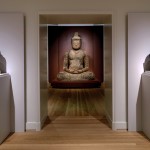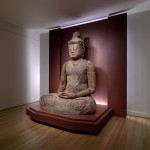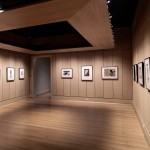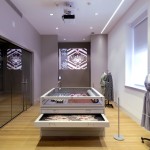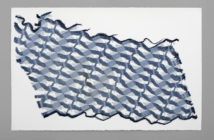The RISD Museum balances an unusual identity. It is an important community museum, but also serves as the university collection for the nation’s preeminent art and design college. Unlike many university museums, which opened during the life of a college thanks to a benefactor or college initiative, the RISD Museum has been with the school from the start. When the Rhode Island School of Design moved into its first purpose built home in the late 1890’s, "museum rooms" were included in the plans. Housed originally in a few galleries attached to RISD’s Waterman Street building, the Museum has since expanded into more generous accommodations. It now houses galleries dedicated to everything from silver made in local factories, to Egyptian artifacts that originate from places thousands of miles away. It also is home to the nation’s oldest collection of decorative arts, housed in the unique Pendleton House wing. Today recognized as one of the great small art museums in the country, the institution recently completed a remarkable renovation of its Asian, Egyptian, and textiles galleries that has increased the vibrancy of visitor experience as well as the immediacy of these collections.
Over the last few decades the Museum has undergone a transformation of sorts. In the early 90’s, the construction of a new wing dedicated to contemporary art reenergized the sleepy college institution. In the 2000’s the grand and contemporary Chase Center was constructed. It expanded exhibition space, gave the museum a second entrance, and added rooms for students to interact with objects up close. The Museum has gradually updated its more historic galleries, embarking in 2006 on a restoration of its Radeke Building, which houses the bulk of its encyclopedic collection. The sixth floor galleries in this building, dedicated to arts of Asia and Egypt as well as the Museum’s textile and costume collection, were the last in need of serious attention. Just over a year ago, the Museum closed the floor and relocated pieces from its popular Egyptian collection to the original "museum rooms" downstairs. After many months of construction and a total reinstallation of the objects housed there, the floor reopened to the public on Friday, June 13th. The effect of the renovated galleries is stunning.
The galleries have been completely rearranged and the objects within reinterpreted to provide new insights for visitors from all backgrounds. On a practical level, the outdated galleries have been given new lighting systems and beautiful display cases in addition to a revised floor plan. The building’s southernmost stairwell has also been beautifully restored. Once walled off and accessed by an unsightly fire door, the stairwell has been opened up and its original wrought iron railing elegantly recreated. A long shuttered skylight above the stair has also been returned, showered natural light through the Radeke Building’s six floors.
Nearby, perhaps the most remarkable room on the floor is a reinstalled gallery dedicated to the Abby Aldrich Rockefeller Japanese Print Collection. Designed in 1952 by legendary modernist Phillip Johnson, the intimate and wonderfully unique gallery was formerly located on the east side of the building. During the renovation it was recreated on the opposite side of the building to the architect’s specifications. On view is an array of stellar Japanese woodblock prints pulled from a collection of 700 donated to the Museum in the 1930’s by Mrs. Rockefeller. The gallery walls are covered in fabric that is interrupted at regular intervals by tiny strips of imbedded copper. In the center of the room, a square wooden soffit hides the lighting that illuminates the treasured objects on display. The room is magnificent. It is both a great example of midcentury American architecture in its own right and a splendid gallery in which to view works by masters such as Hokusai.
Neighboring the Johnson designed print gallery is the Rip Hudner Buddha Gallery which houses one of the Museum’s most beloved objects. The Dainichi Buddha (ca. 1150-1200) has been at home in the Museum since the 1930’s. Nearly 10 feet tall, the piece is the largest wooden Japanese Buddha in the United States. Reinstalled on a new pedestal, the Buddha has also been conserved during the renovations and relit in its remodeled gallery, making it more impressive than ever. The Hudner Gallery’s changes are emblematic of much of the rest of the rejuvenated sixth floor. New lighting above the Buddha and the restoration of a once bricked up window behind it provide the piece with an unusual glow. The result is a space so meditative that visitors almost universally take a seat and stay a while.
Competing for attention with the Buddha is another popular object, the coffin and mummy of the Ptolemaic-period priest Nesmin, dating to 250 BCE. Installed in a new case, the constituent parts of the mummy and his coffin can be fully appreciated for the first time. Visited by scores of Rhode Island school children over the course of many decades, Nesmin is likely the best-known object in the Egyptian collection. Moved to a new gallery, the piece is surrounded by other ancient Egyptian funerary objects. The curatorial strategy gives the gallery a bold thematic vision, one that enhances the viewer’s experience of every object and lends valuable context and depth to the pieces being displayed.
Also on the floor, the new Angelo Donghia Costume and Textiles Gallery and Study Center provides much needed space to present the Museum’s 26,000 item strong collection of textiles and costumes. The gallery proper is painted in a rich gray providing a dramatic backdrop for the beautifully lit objects in a large central case. The room unintentionally takes on a quiet and contemplative nature similar to that of the nearby Buddha. It is even aw inspiring at times, but the arrangement is engaging and exciting. The adjacent study room is fully equipped with iPads and glass-covered drawers holding items that visitors are welcome to explore. A restored window in this space looks out onto the Museum’s intimate central courtyard.
Beyond the major spaces, other items shine in new arrangements. Well curated and deeply thought out, the remodeled sixth floor galleries are a truly great achievement for the RISD Museum. The new spaces are being presented with a campaign titled "New Look. Old Favorites." This slogan underscores the importance of the Museum to the people of Rhode Island. While the galleries are indeed new, the objects therein are the same ones that Rhode Islanders have enjoyed for generations. In their new cases and remodeled galleries, all the pieces on the RISD Museum’s sixth floor can be reconsidered and better understood by even the most seasoned visitor.
Further, the renovation allows the quality of the objects and the scholarship at the Museum to take center stage. While the qualifiers often used to describe the RISD Museum are valid, they cannot really do justice to the marvelous institution they describe. The RISD Museum is not just a great university museum, or a great small museum, or a great community museum, or a great regional museum. The RISD Museum is a great museum, period, and the stunning renovation of these galleries proves that. It is a crowning achievement, capping off a more than century old commitment to bringing the best in museum programming not only to the university community, but also to the City of Providence and the State of Rhode Island.
All images courtesy the Museum of Art at the Rhode Island School of Design.







